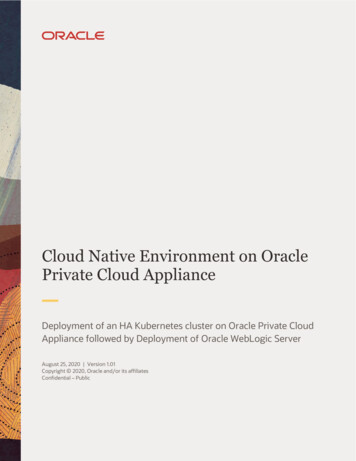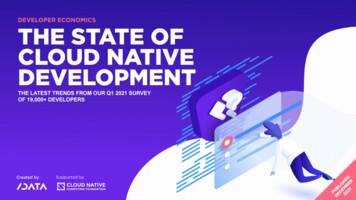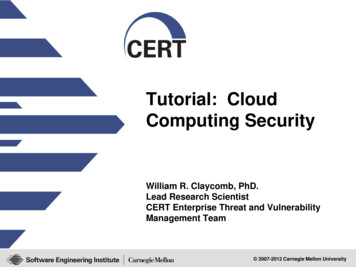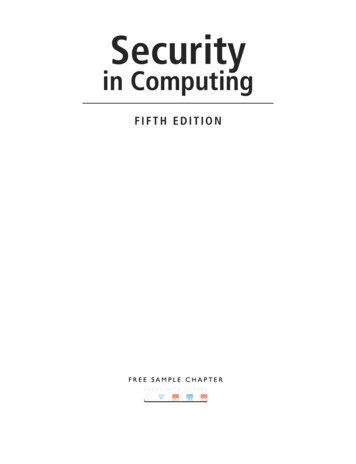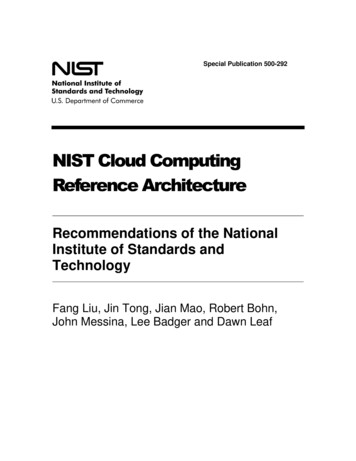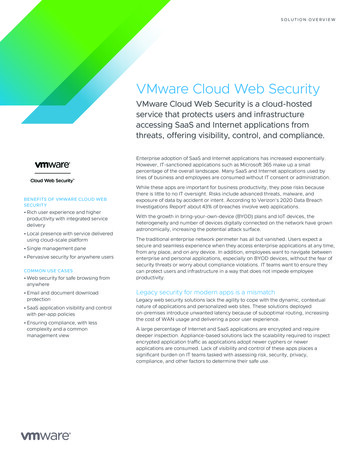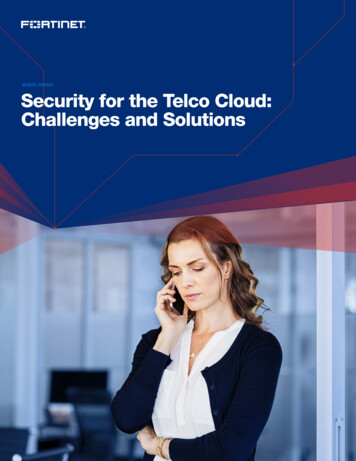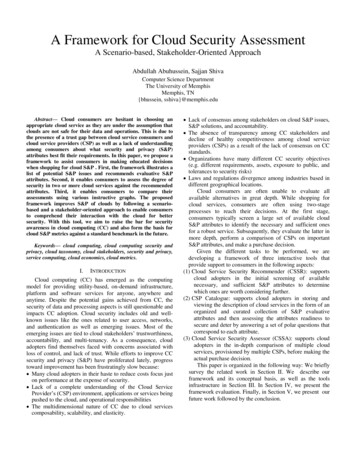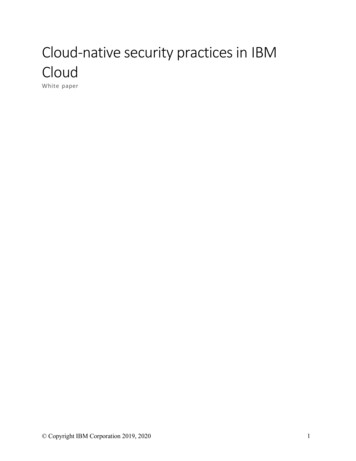
Transcription
Cloud-native security practices in IBMCloudWhite paper Copyright IBM Corporation 2019, 20201
Table of ContentsCloud security shared responsibility model . 3Shared responsibility for security in cloud services. 4IBM Cloud: When using PaaS . 4IBM Cloud: When using SaaS . 5A secure journey to cloud: Culture, skills, and expertise . 5Cloud-native security practices . 6Manage user identity and access. 8Isolate and protect the network . 8Enable protection for data at rest, in transit and in use . 8Manage cloud security posture, compliance, and threats . 9Cloud security and compliance . 11Compliance . 11Data privacy . 11Data centers . 12Building a cloud cybersecurity management system. 12Cybersecurity policy and operations governance . 12Cybersecurity risk management program and assessment . 13Cybersecurity controls definition and gap assessment . 13Cybersecurity threat management operations process and analysis . 13IBM Cloud security portfolio . 14Further information . 14 Copyright IBM Corporation 2019, 20202
IntroductionIBM Cloud is IBM’s high-performing public cloud platform, with data centers around the world thatdeliver cloud computing options from infrastructure as a service (IaaS), platform as a service (PaaS) tosoftware as a service (SaaS). Security is a fundamental design principle for our cloud platform withmarket-leading security capabilities enabled for regulatory workloads.Additionally, the IBM Security business unit provides advanced cybersecurity capabilities that run onthe platform. Whatever you need to run: compute-intensive workloads, cloud native or commercialapplications, big data, analytics, or AI, IBM Cloud helps businesses innovate with confidence.This paper lists fundamental cloud-native security practices, with a focus on how to use them in IBMCloud. It incorporates common practices from across IBM’s global client base and industry bestpractices. The scope spans cloud security strategy, operations, management, shared responsibilities, andcontrols to meet compliance requirements. Cloud security is accomplished in layers, with particularattention on data and workloads in a cloud-native world.This paper is designed for security and technology professionals who are evaluating or deployingworkloads in the IBM Cloud. It covers the scope of concerns from deployment of a single application tocomplex, hybrid or multi-cloud environments. If you are starting out the information here will set you onthe path to cloud native best practices, if you are transforming your enterprise the topics defined here willlet you more easily identify gaps and opportunities to improve your security profile.Cloud security shared responsibility modelSecuring the cloud depends on a shared responsibility model. By understanding the properresponsibilities, clients can better avoid security gaps.Consider an example where IBM is the provider that sets up the home security system, but a business isthe tenant who sets up access code. Who is responsible for ensuring that the alarm is active when thehomeowner is away? It’s a shared responsibility, where the client must activate the alarm and theprovider must ensure that it is actively monitored.In the model that follows, the tenant is responsible for all aspects of security in light blue, while theprovider has obligations for enabling security for the components in dark blue.For IBM Cloud generally, IBM as the provider is responsible for the security of the data center, hostingthe servers, and the connectivity and uptime of the data center for the tenant’s use.IBM Cloud comprises a set of trusted facilities and systems. All locations adhere to the samestandards and controls. Tenants can achieve compliance with controls and certifications bycombining their responsibilities with IBM’s responsibilities. Copyright IBM Corporation 2019, 20203
Shared responsibility for security in cloud servicesIBM Cloud: When using IaaSAs the provider, IBM is responsible for the security of the data center, hosting the servers, and theconnectivity and uptime of the data center for the tenant’s use. IBM provisions the servers, virtual orotherwise. As the tenant, the client is responsible for these activities: Securing the entire workload, including servers, operating system updates, and patching,securing the applications, data, managing access, monitoring, and threat management.While IBM Cloud provides the VPN for VPC service that encrypts traffic by using IKE/IPsecfrom the client’s premises to within the client's VPC, if a client requires true end-to-endencryption of traffic from their premises endpoint to their IBM Cloud VM, establishing thatend-to-end encryption is the client's responsibility. If the application can be updated, TLS v1.2or later should be used to establish layer 4 encryption end-to-end. Where the applicationcannot be updated, an IPsec tunnel should be used between the endpoint and the VM toestablish layer 3 encryption.Using IBM’s tools or its own tools to manage and secure workloads and data,independent of IBM.Hiring IBM service teams or other third-party teams to provide services, such as any securitymanagement and administrative tasks. These services are done upon request. When IBMfulfills such requests, it acts as an extension of the tenant.IBM Cloud: When using PaaSWhen it comes to PaaS, IBM as the provider is responsible for platform services that deal with applicationdeployment. Those services include Kubernetes Services, data services such as object storage or databaseservices, and other enabling application integration services, such as identity services, messaging services,logging services, and DevOps services. Copyright IBM Corporation 2019, 20204
IBM is also responsible for enabling security for the server configuration, patching operating systemsand middleware in a timely manner, and the threat management of those platform components. As thetenant, the client is responsible for these activities: Maintaining the security of the applications and data that it installs or runs on theplatform.Monitoring, threat detection, and responses on the application and data.Using IBM’s tools or its own tools to manage and secure applications and data,independent of IBM.The tenant might hire IBM service teams to provide security management and assist withdefined regulatory compliance and reporting requirements. In such cases, IBM acts as anextension of the tenant, who is still responsible for the security of its applications and data.IBM Cloud: When using SaaSAs the provider, IBM is responsible for the cloud stack, but as the tenant, the client is responsible forthese activities: Maintaining the security of any data that is processed and that it introduces into theservice at any level in the stack.Proactive data protection, encryption, key management, access control, data and IP theftdetection, and responses on data incidents.Using IBM’s tools or its own tools to manage and secure workloads, independent of IBM.Might hire IBM service teams to provide security management and assist with definedregulatory compliance and reporting requirements. In such cases, IBM acts as an extension ofthe tenant, who is still responsible for the security of its data.A secure journey to cloud: Culture, skills, and expertiseAs clients look to meet their security responsibilities (IaaS, PaaS, and SaaS), it’s important to understandthe fundamental shift in culture, skills, and expertise. People, culture, process, and technology all mustadjust to embrace the cloud-native paradigm that is brought forward by cloud environments. Architectsand developers need to adopt secure-by-design or threat- modeling concepts upfront in the process toidentify any gaps, design security in, and remediate issues before they deploy a vulnerable application. Inshort, as part of the DevOps approach, security must “shift left” in the design, development, andoperational processes so that security is a forethought and becomes a DevSecOps model that is embracedby the entire organization.Clients that are adopting cloud need to enhance the skills of their staff or acquire skilled members andintegrate them into their current teams in a programmatic way. The teams must be trained to maintainthe corporate defined standards while they use a specific cloud service provider. Deep expertise of thecloud service provider environment is required while incorporating cloud configurations, leveragingnative-to-cloud provided security features. Copyright IBM Corporation 2019, 20205
The automation of activities such as penetration testing, configuration, deployment, alerting, andremediation is a foundational design principle in achieving continuous security. To achieve repeatablesecurity, clients need automated deployments that use formation templates, monitoring and managementof cloud-native workloads by using cloud service provider features, and APIs.IBM Security and the IBM Garage Methodology bring extensive expertise and offerings to advise andsupport clients on their journeys to cloud adoption. Advisory and managed security services can beprovided by using a combination of IBM Security and the IBM Garage Methodology based on theclient’s scenario and requirements. Advisory and managed services offerings include Governance, Risk& Compliance, Security Operations (SIOC), X-Force Threat Management (XFTM), X-Force OffensiveTesting (XF RED), X-Force Intel & Response (XF IRIS), and others.Cloud-native security practicesThe effect of cloud on security practices and operational focus is transformative. Adoption of cloudservices presents an opportunity to rethink and improve the security practices used to build, deploy, andmanage applications. In the cloud services model security becomes a joint responsibility between theclient and the cloud provider. After cloud adoption begins, organizations will find the focal points andresponsibility for security shifts from traditional perimeter-based controls and infrastructure centricpolicies to security controls and policies more focused on overall operational practices, including dataand workload technologies and development practices.New cloud development and operations models have an overall effect on an organization’s securityculture. Continuous development is one of the most valuable features of the cloud native model, andsecurity cannot lag releases. The goal of the cloud native organization is to maintain continuousdevelopment and achieve continuous security. To keep pace application teams must take on more securityresponsibility and accountability and developers must be enabled to embed security into the DevOpsprocess. When security is baked into your DevOps and culture from the beginning you’ve achievedDevSecOps.A thoughtful approach to aligning security practices begins with an overall consideration of yourorganization’s cloud security strategy and approach: Take a risk-based view: You need to know what kinds of workload and data you are able tomove to the cloud and which need transformation. Starting with a risk-based assessmentgives you visibility, and a high-level roadmap for phasing your cloud adoption.Understand the shared responsibility model: Review the provider’s cloud terms of serviceand your organization’s existing security policies and requirements, including regulatorycompliance. Identify if responsibilities have shifted from you to the provider, or if there aregaps in your existing policies or responsibilities matrix. Copyright IBM Corporation 2019, 20206
Establish a collaborative culture and organization: Drive a collaborative culture betweenapplication, IT/ops, and security teams where application teams understand the importanceof security and compliance in their role.Define, review or modify controls and processes: Security must be a forethought and not anafterthought. Take an end-to-end approach to achieve this on IBM Cloud. Ensure that theright controls and processes are in place to adopt a cloud native approach from the very firstdeployment. Security should be part of reviews of design and architecture. Include thesecurity team in reviews.Practice continuous monitoring for security and compliance: Security controls are not onetime enforcement actions. Instill the practice in the organization, process, and culture, anduse technologies and tools.Ensure proactive planning for cybersecurity events: Prepare for an orchestrated response toincidents, including keeping incident response professionals such as IBM X-Force IRIS onretainer.Clients require an end-to-end approach to security that helps them achieve the three coreobjectives shown in the figure below. These include structured security practices like: Consistent use of network protection and identity and access management (IAM) toolsto control accessIncreased client control and fortified workloads to protect dataContinuous security and compliance with through clearly communicated controls,monitoring and both broad and targeted threat management, which add efficiency andvisibility to how risk and compliance requirements are monitored and managed. Copyright IBM Corporation 2019, 20207
Manage user identity and accessManage access to cloud resources by setting authentication and access policies with IBM Cloud IAM.You can specify which users or services can access which cloud resource on IBM Cloud. For example,your administrators can set policies so that only a particular user has administrative access to createvirtual servers or Kubernetes clusters. You can also require users to authenticate with multifactorauthentication when they access your cloud resources.Access to applications requires the same attention as access to cloud resources. Business applications arethe gateway to your business’ or your customer’s data. It is your responsibility to add authentication to theapplications that are built on IBM Cloud. IBM Cloud App ID allows developers to add enhancedauthentication to their web and mobile applications and better secure their cloud-native applications andservices on IBM Cloud. Developers can extend this authentication with IBM Security Cloud Identity foradvanced capabilities such as device verification and drive toward the goal of adaptive risk-basedauthentication.Isolate and protect the networkThe need for isolated and secure private network environments is central to layered security protection.VPCs, firewalls, VLANs, routing, and VPNs are all necessary to create isolated private environments.This isolation enables virtual machines and bare-metal servers to be more securely deployed in complexmultitier application topologies and be better protected from risks on the public internet. DistributedDenial of Service (DDoS) attacks are a frequent threat. IBM Cloud Internet Services is a rich set of edgenetwork services that clients can use to better secure internet-facing applications from DDoS attacks,data theft, and bot attacks.The approach to cloud native network security must also consider the service types in use. To safeguardthe network from an application located on a public cloud isolation, segmentation and microsegmentation might be used. For customers using IaaS, isolation can be achieved by using a virtualprivate cloud (VPC). Additionally, security groups can add instance-level security to manage inboundand outbound traffic on both public and private network interfaces. Containers require additionalattention when it comes to network security. When building cloud-native applications with a KubernetesService, limit the worker nodes or applications that can be accessed externally and use network policiesto manage cluster isolation.Enable protection for data at rest, in transit and in useAs you look ahead to the next era of computing, there are many predictions and assumptions about whatthe next great innovation might be, but one thing is indisputable: data and securing that data is and willremain important to companies and consumers. The protection of data and the management of encryptionkeys are standard items in security policies and controls. IBM Cloud encrypts the data in database andstorage services with built-in encryption. For higher levels of data protection, you can manage theencryption keys that encrypt the data at rest. For sensitive data, gain control of encryption keys by usingBring Your Own Key (BYOK) with IBM Cloud Key Protect. Clients can hyper-protect data and keeptheir own keys with exclusive control of the keys and the hardware security modules (HSM) by usingKeep Your Own Key (KYOK) with IBM Cloud Hyper Protect Crypto Services. For highly sensitive data,clients can consider encrypting the data at the application level before they store it in a cloud data service. Copyright IBM Corporation 2019, 20208
To help secure data in transit use TLS/SSL-enabled endpoints for applications and APIs. In Kubernetesenvironments, clients can enable TLS termination for cloud-native applications in the ingress controller anduse TLS termination IBM Cloud Load Balancer Service when they deploy workloads on infrastructure withvirtual servers or bare metal. For inter-cluster communications within a service, clients can centrallymanage the certificates by using IBM Cloud Certificate Manager. With better visibility to your certificatelifecycle and automated expiry notifications you can proactively manage certificate expirations and avoidservice outages. Connectivity to data centers in hybrid deployments often need a better secured tunnel, suchas is provided by IBM Cloud Virtual Private Networks. In the above context, references to TLS indicateTLS v1.2 or later.As the reliance on data grows in the era of hybrid cloud, the need for data privacy becomes even morecritical for everyone, and for businesses, it’s imperative. Confidential Computing protects data in use byperforming computation in a hardware-based Trusted Execution Environment. That secure and isolatedenvironment prevents unauthorized access or modification of applications and data while in use, therebyincreasing the security assurances for organizations that manage sensitive and regulated data.IBM has been investing in Confidential Computing technologies for over a decade and is on its fourthgeneration of the technology, delivering on end-to-end Confidential Computing for its clients’ cloudcomputing for more than two years. From IBM’s point of view, data protection is only as strong as theweakest link in end-to-end defense, which means that data protection must be holistic. Companies of allsizes require a dynamic and evolving approach to security that is focused on the long-term protection ofdata. Solutions that might rely on operational assurance alone don’t meet IBM’s standards.IBM first announced generally-available Confidential cloud computing capabilities in 2018 with the releaseof IBM Cloud Hyper Protect Services and IBM Cloud Data Shield. The family of IBM Hyper Protect CloudServices is built with secured enclave technology that integrates hardware and software and leveragesthe industry’s first and only FIPS 140-2 Level 4 certified cloud hardware security module (HSM) to provideend-to-end protection for clients’ entire business processes. IBM Cloud Data Shield provides technologythat helps developers to seamlessly protect containerized cloud native applications without needing anycode change.Data classification and data activity monitoring are two effective methods to help secure criticalinformation. Before a client can adequately protect sensitive data, the client must identify and classify it.Automating the discovery and classification process is a critical component of a data protection strategyto prevent a breach of sensitive data. IBM Security Guardium provides integrated data classificationcapabilities and a seamless approach to finding, classifying, and protecting the most critical data, whetherin the cloud or in the data center. Activity monitoring provides visibility into who is accessing sensitiveinformation and what information is being accessed, creating alerts when certain conditions are met, andeven blocking or quarantining connections where warranted.Manage cloud security posture, compliance, and threatsAs enterprises move regulated workloads to public cloud, it is essential to prove that security andcompliance concerns are handled better, faster, and easier than their status quo. IBM recognizes themagnitude of these issues for all types of clients who are moving workloads to public cloud. The sheercomplexity they have to endure to achieve a security or compliance standard is exhausting.At the heart of the solution to achieve continuous security and compliance is the IBM Cloud Security andCompliance Center. The Center is a new security and compliance management platform on IBM Cloudwhere customers can define controls, assess posture, monitor security and compliance, remediate issues, andcollect audit evidence. For example, an enterprise might define a collection of controls, such as a sensitive Copyright IBM Corporation 2019, 20209
workload profile, to address the security and compliance requirements for a cloud-native application thathandles sensitive data. These controls can cut across data security, network protection, identity and accessmanagement, application security, and audit logging. From the enterprise policy framework, the controls arethen standardized based on the NIST 800-53 control set. By adopting DevSecOps methodology, clients canalso shift left to enforce appropriate guardrails as part of their CI/CD pipelines where security gates can bedefined. In addition to posture management, the Center brings together capabilities to define configurationrules to enable governance and integrate to the capabilities of IBM Cloud Security Advisor that provideinsights about vulnerabilities and threats.With capabilities from IBM Cloud Security and Compliance Center and by aligning with IBM CloudSatellite to enable enterprises to take advantage of their distributed cloud environment, clients can assess thesecurity and compliance posture of their workloads in a hybrid cloud deployment.Cloud governance, security and risk policies, and industry compliance standards all rely on some level ofmonitoring, reporting and audit. To guarantee an audit trail means tracking user access activities. IBMCloud Activity Tracker, on IBM Cloud provides aggregated activity logs of administrative and developeractions completed on IBM Cloud resources. These logs are needed by DevSecOps and other securityteams to carry out their duties. Security teams can also instrument applications so user or transactions logscan be sent to a logging store or other security system. IBM Cloud Log Analysis with LogDNA can beused as that log service.Vulnerability and patch management processes and solutions need to be established according to the tasksand accountabilities associated with a shared responsibility model. During your planning phase assessrisks and identify threats that need to be handled, such as malware, for endpoints, virtual machines andbare-metal servers. The IBM Cloud marketplace has catalogs of trusted vendors for these kinds ofsolutions.Managing vulnerabilities in applications is an important part of managing security and complianceposture. With IBM Cloud Security Advisor, which is now integrated into IBM Cloud Security andCompliance Center, clients can get an integrated view of their security and compliance posture acrossvulnerabilities and certificates. IBM Cloud Security Advisor also provides a way to integrate the client’ssecurity tools and third-party security tools. There are tools to help ingrain security into your DevOpspractices, assuring that security is considered upfront in the development process from build throughdeployment and runtime. Use Vulnerability Advisor in IBM Cloud to detect and manage vulnerabilities in Copyright IBM Corporation 2019, 202010
container images when building, deploying, and managing cloud-native applications. Run networkvulnerability scans for any endpoints on the IBM Cloud network.An organization’s cloud threat management approach needs to be defined and integrated in the context oftheir overall threat management and security operations. The cloud threat management planning beginswith the risk assessment of your cloud workloads and what kind of monitoring and reporting is necessary.To get an integrated view of security information and event management integrate cloud platform logs andflows into IBM Security QRadar. With this view, security analysts can manage incidents appropriatelythrough IBM Resilient. Use the security and cyber expertise of IBM Security Managed Security Servicesto better manage the security of the enterprise and cloud platform. The IBM Security Managed Securityservices teams can provide a range of capabilities from “a single pane of glass” for hybrid multi-cloud tospecific solutions for container security.Cloud security and complianceCompliance with controls is a top consideration that organizations encounter when they decide to fullyengage in a cloud-first strategy. Clients can address compliance in the cloud and capitalize on the businessagility and growth that the cloud inherently provides.ComplianceIBM Cloud is designed for organizations that want a cloud environment that’s security-rich, open,hybrid, multicloud, and manageable. IBM Cloud compliance and trust certifications reaffirm IBM'scommitment to protection of customer data and applications. Designed with secure engineeringpractices, the IBM Cloud platform features layered security controls across network and infrastructure.For more information, see IBM Cloud compliance programs.To achieve compliance for the workloads and applications that run on IBM Cloud, clients areresponsible for ensuring security controls and managing those for their part of the shared responsibilitymodel, as described earlier.Data privacyIBM is committed to protecting the privacy and confidentiality of personal information about itsemployees, clients, Business Partners (including contacts within clients and Business Partners), and otheridentifiable individuals. Uniform practices for collecting, using, disclosing, storing, accessing, transferring,or otherwise processing such information assists IBM to process personal information fairly andappropriately, disclosing it or transferring it only under appropriate circumstances.With nearly 60 data centers across six continents, IBM offers a cloud architecture that enables clients toknow exactly where their data and applications are running in the IBM global data center network. IBMis fully committed to protecting the privacy of clients’ data. While there is no single approach to privacy,IBM complies with applicable data privacy laws in all countries and territories in which it operates. IBMsupports global cooperation to strengthen privacy protections. Copyright IBM Corporation 2019, 202011
Protecting clients’ data is mission-critical to IBM Cloud. IBM services are designed to protect clients’proprietary content and data. Access to data is strictly controlled and monitored in accordance withIBM’s internal privileged user monitoring and auditing programs.For more information about cloud privacy, see Privacy on the IBM Cloud.Data centersIBM’s data centers are built with multiple deployment options for clients’ unique workload needs.Clients can choose where to deploy from nearly 60 locations in 19 countries. IBM also offers 13 TBpsof connectivity between data centers and network points of presence and three separate networks: apublic, private, and internal management network in each data center around the globe.All IBM data centers have industry certifications to better help clients build compliance into a completecloud solution. Compliance is a critical decision point for organizations that are adopting a cloudplatform. Moving internal workloads to the cloud can provide key business and technical benefits, suchas elasticity, flexibility, and op-ex model. But moving to the cloud also me
Cloud-native security practices The effect of cloud on security practices and operational focus is transformative. Adoption of cloud services presents an opportunity to rethink and improve the security practices used to build, deploy, and manage applications. In the cloud services model sec
